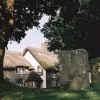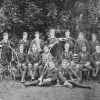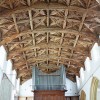Arne stands on a peninsula between the Isle of Purbeck and Poole harbour. The parish is entirely rolling heath land with a farm and a small number of houses. It furthermore includes parts of the earlier Wareham Holy Trinity parish. Not spoilt for amenities, Arne has no shops, no public houses, nor restaurants in the village and motorists are encouraged to leave their vehicles in the car park and walk to the village – a distance of about half-a-mile. The car park serves the Royal Society for the Protection of Birds nature site, which surrounds Arne and attracts visitors interested in the rare birds who make this their home.
From about 948 AD Arne belonged to Shaftesbury Abbey and the church, built in the early 13th century, is dedicated to St. Nicholas and is attractively sited at the foot of a wooded hill. The architecture is Early English: a single cell structure comprising nave and chancel with a south porch where above the door are the remains of an early fresco. The upper part of the west end of the nave was partitioned off in the 17th century to make room for a bell gallery; Hutchins mentions a bell in this gallery having the initials: ID-RRT and the date 1625. There being no tower, the solitary bell cast in 1782 and replacing the original bell of 1625 hangs in the roof space. The heads of some of the windows were hewn out of a single stone. The East Window, being a triplet, dates the building at around 1220 AD.
The altar is made from a pre-Reformation stone, which was found buried outside, has five small crosses carved on it and sits on a timber frame. Near the altar is a piscine; probably original 13th century it has a acutely pointed head and round drain. There are several monuments and floor slaps inside the chancel area the oldest being a floor slab “to Mary, wife of Thomas Baker Jun., 1673/4.”
In the 3rd (edited) edition of Hutchins there is mention of a linen cloth embroidered with the emblems of the Trinity presented as a gift to the church in 1861 by William Wake, Rector of Holy Trinity. Arne had been a chapel of ease of Holy Trinity since the 15th century and earlier it had been a chantry.
Outside there are five buttresses all apparently added during a restoration in the 19th century.
Looking from the altar window of this ancient place, built all those years ago by the order of the Abbess of Shaftesbury, you can see across the heath land to the shipping roads and watch the modern day ferries majestically sailing to and from Poole harbour. The view is delightful.
The name Arne is derived from the Saxon ‘Aerne’ meaning a house or secret place.



